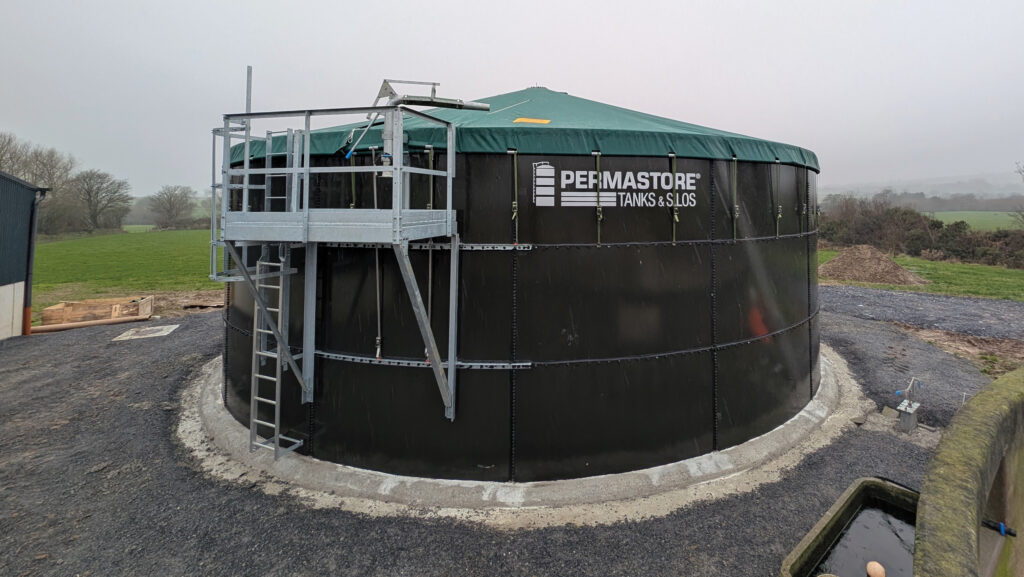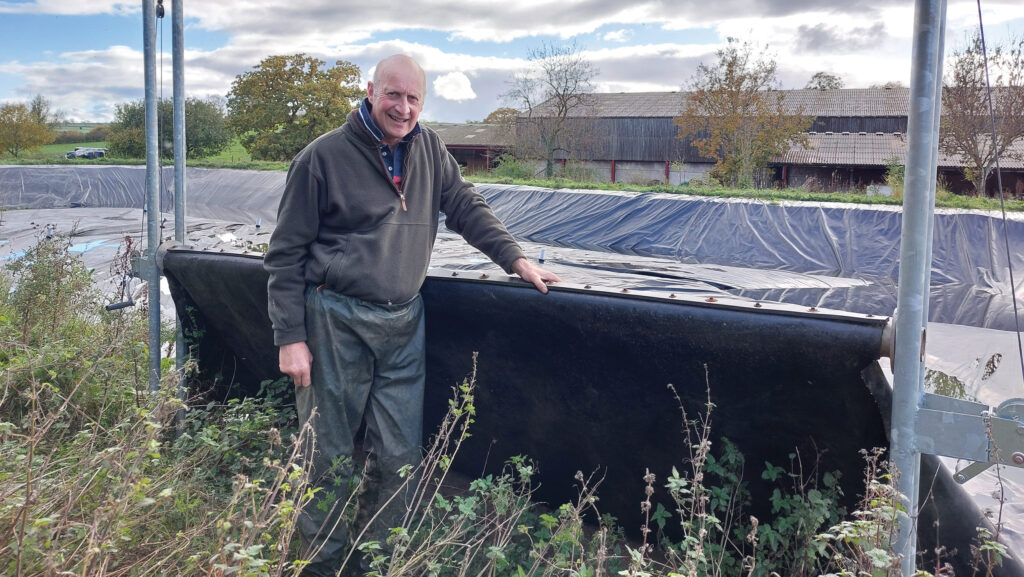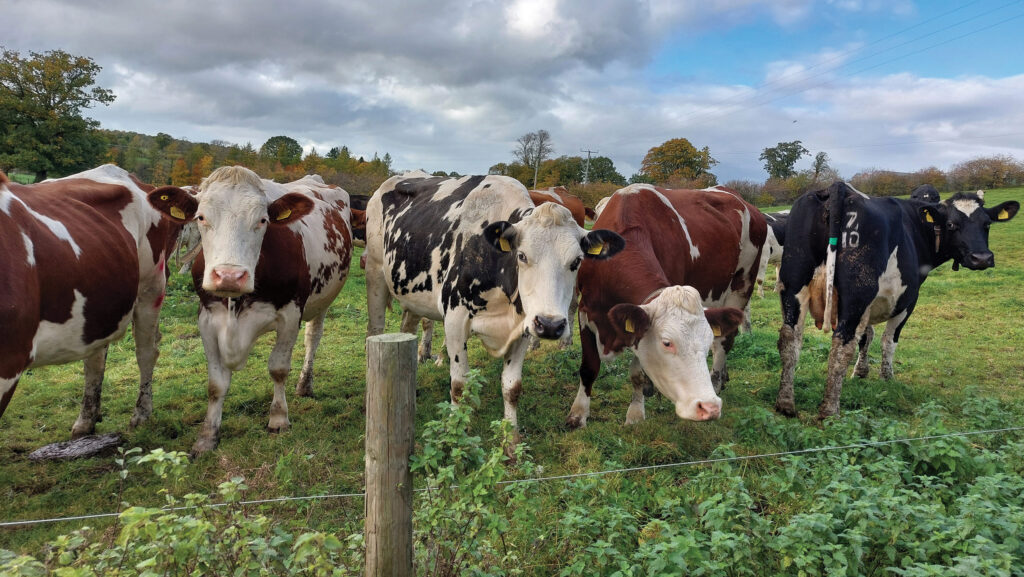Advice on investing in a cover for a slurry lagoon or tank
 Slurry lagoon cover at Greystones House Farm © MAG/Shirley Macmillan
Slurry lagoon cover at Greystones House Farm © MAG/Shirley Macmillan Huge reductions in emissions can be achieved by fitting impermeable covers over slurry storage – as much as 80% on an above-ground tank and 50-60% by permeable floating materials, according to research.
Yet a cover is not just a purchase to meet environmental legislation, or capture grant funding.
From rainwater harvesting and recycling, to retaining more nitrogen and creating a uniform source of crop nutrients, investing in a slurry cover pays back.
See also: How a Wiltshire dairy makes better use of slurry
It is an opportunity for livestock farms to rethink their whole slurry/muck handling and storage system, says Trevor Linton of Linton & Robinson Environmental, based in County Tyrone.
He has been installing permeable and impermeable materials to cover above tanks and lagoons (on dairy and pig farms) for seven years, and finds a negative mindset persists that slurry is a waste disposal cost.
“Farmers would rather buy a new tractor than invest in their slurry system.
But a good system will make a big difference as you will get more out of your slurry – you can spread it when you want, not have to put it out because your storage is full,” he says.

Covered slurry store © Linton & Robinson Environmental
Benefits of upgrading
Upgrading handling and storage increases capacity, streamlines flow, and makes pumping easier.
Automation can make mixing easier and is cheaper when electric mixers are powered by a farm’s solar panels.
Programmed to run regularly, automation also keeps slurry homogenised.
“The first load is the same as the last, so it can be spread at any time you are ready to go on land,” Trevor says.
Separating slurry is another win – covering just the liquid and stacking the solids avoids bedding materials or spoiled silage forming a crust that sticks to the cover.
Liquid slurry is also easier to apply direct to the soil surface.
Covered stores lose less nitrogen, leaving a more nutrient-rich product to apply to land.
“You can harvest rainwater off the top and, because it is clean water, it can be used for washing down the parlour, for instance,” Trevor adds.
Installation
However, retrofitting a cover to existing storage is not a simple task, says Trevor.
Although floating covers of hexagonal pieces of recycled plastic, which interlock on the slurry surface, can easily fit any size of storage, impermeable versions require more work.
“Older metal slurry tanks weren’t designed for putting covers on, so we have to do extra metal work, which adds financially, and old lagoons lose their shape so need tidying up first,” he adds.
All stores must be completely emptied for installation, as floats – which hold covers and supports – have to be welded in place.
This gives a very short time window to complete the job; a cover for a 1.5m gallon lagoon can be done in a 10-hour day.
Trevor points out that it is also weather dependent for the safety of the installers – any wind above 10-12mph getting underneath the cover turns it into a kite.
Additionally, using mastic in above-ground tanks does not stick on smooth surfaces if they are damp.
“Every single farm is different, so payback and the cost-benefit will be different,” he says, adding that without grant funding, payback is a more “realistic” seven to eight years.
This makes appraising a farm’s current system and researching its future requirements and grants essential.
Chris Addison, Greystones House Farm, Penrith, Cumbria
Farm facts

Chris Addison © MAG/Shirley Macmillan
- 231ha land
- 150-head herd Montebeliarde and crossbred cows]
- Six-month grazing season
- Stocking 70 dairy replacements
- Rearing 250 beef cattle to finish at 24 months
- 20 pedigree suckler cows
- 400 store lambs bought a year
Fertiliser store
It has been nine years since Chris Addison covered his “fertiliser store”.
As an organic farmer, he relies entirely on slurry and muck produced from housing 450 cattle over winter to fertilise grazing paddocks, silage swards and arable land.
He invested in a lagoon in 2009 to better manage his slurry as a fertiliser.
In a high rainfall area of 1,375mm/year, farming at 200m above sea level, and with a river running through the farm, he is very conscious of the environmental impact of slurry spreading.
“I was aware that if we spread slurry at the wrong times we would get run-off, but you have got to have the capacity to store.
“We had a concrete block wall store from 1979, which holds three months’ muck, so we needed to increase capacity – I didn’t want to have to be spreading in winter because it was full,” he explains.
A clay-lined lagoon measuring 66x22m and 5m deep was dug, which gave 10 months’ storage.
Impermeable cover
Having introduced slurry bugs to the lagoon to increase nitrogen density and reduce smell, Chris was able to secure 100% grant funding for a cover in 2016.
This time, his aim was to increase the nutrient value of the slurry because he thought it was losing too much nitrogen – and keep rainwater out.
“We also went from applying with a spread plate to trailing shoe and dribble bar, again to increase nutrient value.”
An impermeable cover, from Linton & Robinson Environmental, was made in the Netherlands to fit the lagoon.
Chris says his contractor spent a week completely emptying the lagoon and relandscaping it at a cost of £8,000. He also bought a 9m mobile stirrer.
The lagoon cover – which has eight vents to release gas build-up – was fitted with two mixing hatches.
When Chris lifts the cover, he can reverse the tractor and stirrer to reach the slurry. Overall, stirring and moving slurry is a three-day process.
Some rainwater is left on the surface to add weight to the cover. The rest is pumped onto neighbouring fields.
Slurry is spread in March on all grassland, then on silage fields after first cut at the end of May, and after second cut in June/July.
White clover in grazing swards and herbal leys on the farm take over supplying nitrogen in summer through fixing. “Slurry lends itself to early-season growth,” he says.
On reflection, Chris says he would have chosen to have more site entry points for the stirrer.
He is now considering a slurry separator, and whether he could make better use of the rainwater on the cover’s surface.
When the lagoon was new, he had 350 cattle. Since adding the cover, numbers have increased to 450, but storage capacity remains at 10 months.

Cows at Greystones House Farm © MAG/Shirley Macmillan
Slurry cover rules
Covers and, potentially, additional regulatory requirements for dairy farms or intensive beef production are anticipated, says the AHDB’s lead environmental specialist, David Ball.
Defra is reviewing current legislation, he says. The aim is to consolidate nitrate vulnerable zones, silage, slurry and agricultural fuel oil regulations (known as SSAFO), and Farming Rules for Water.
Air quality and some soil health measures may also be included in the new legislation.
Slurry covers were originally proposed in 2019 by the Clean Air Strategy for England as part of a range of measures to reduce ammonia emissions.
The deadline of 2027 was, however, subject to consultation and supporting evidence, yet a change of government put plans “on the backburner”, says David.
Interest has now been revived by a recent House of Lords report on nitrogen, advising that agriculture needs to step up its activity, otherwise it will not achieve emissions targets.
So, although David says slurry storage covers are unlikely to be required from 2027, he believes they will become mandatory within three or four years.
Already, recent grant funding for new slurry storage required impermeable covers to qualify, he points out.
